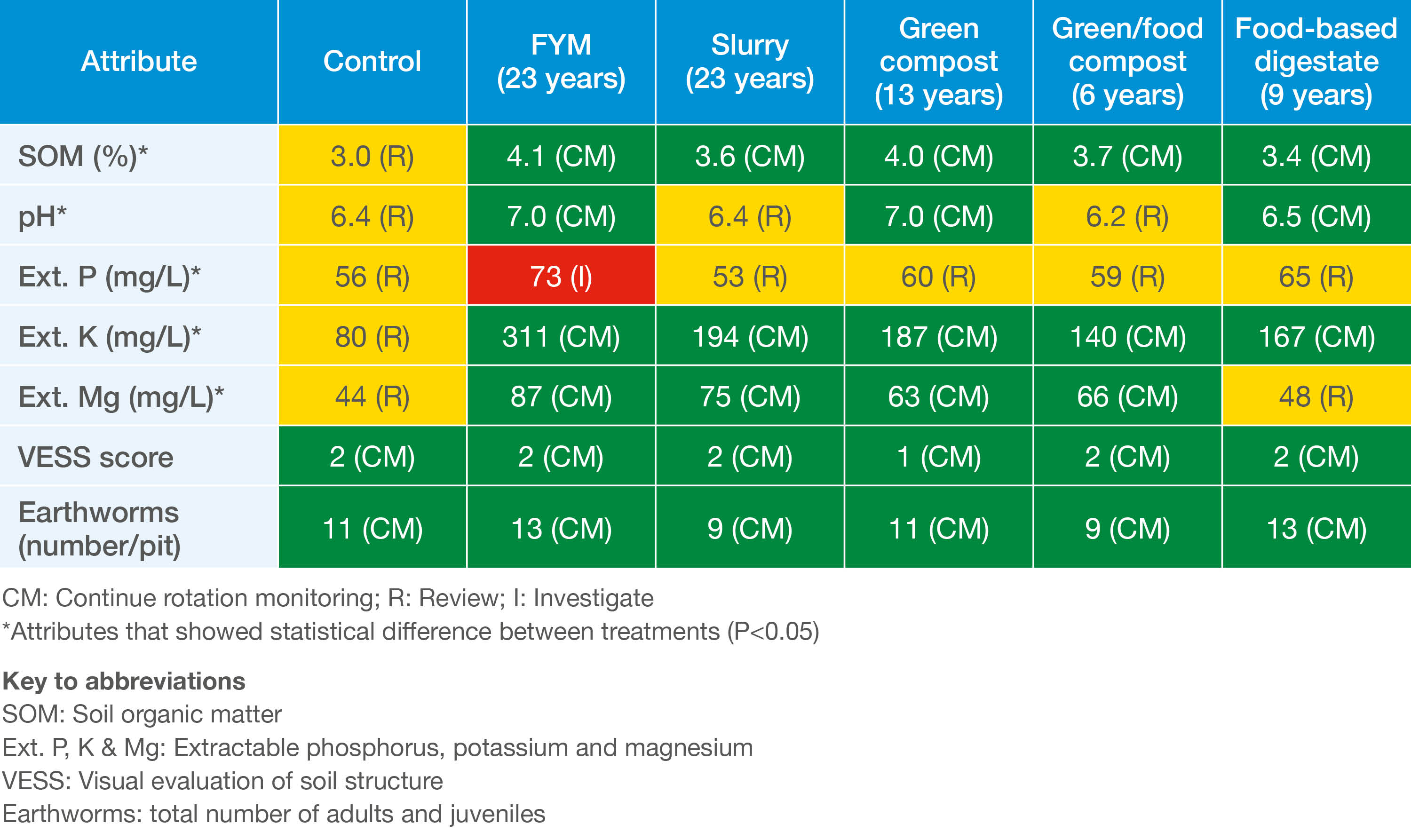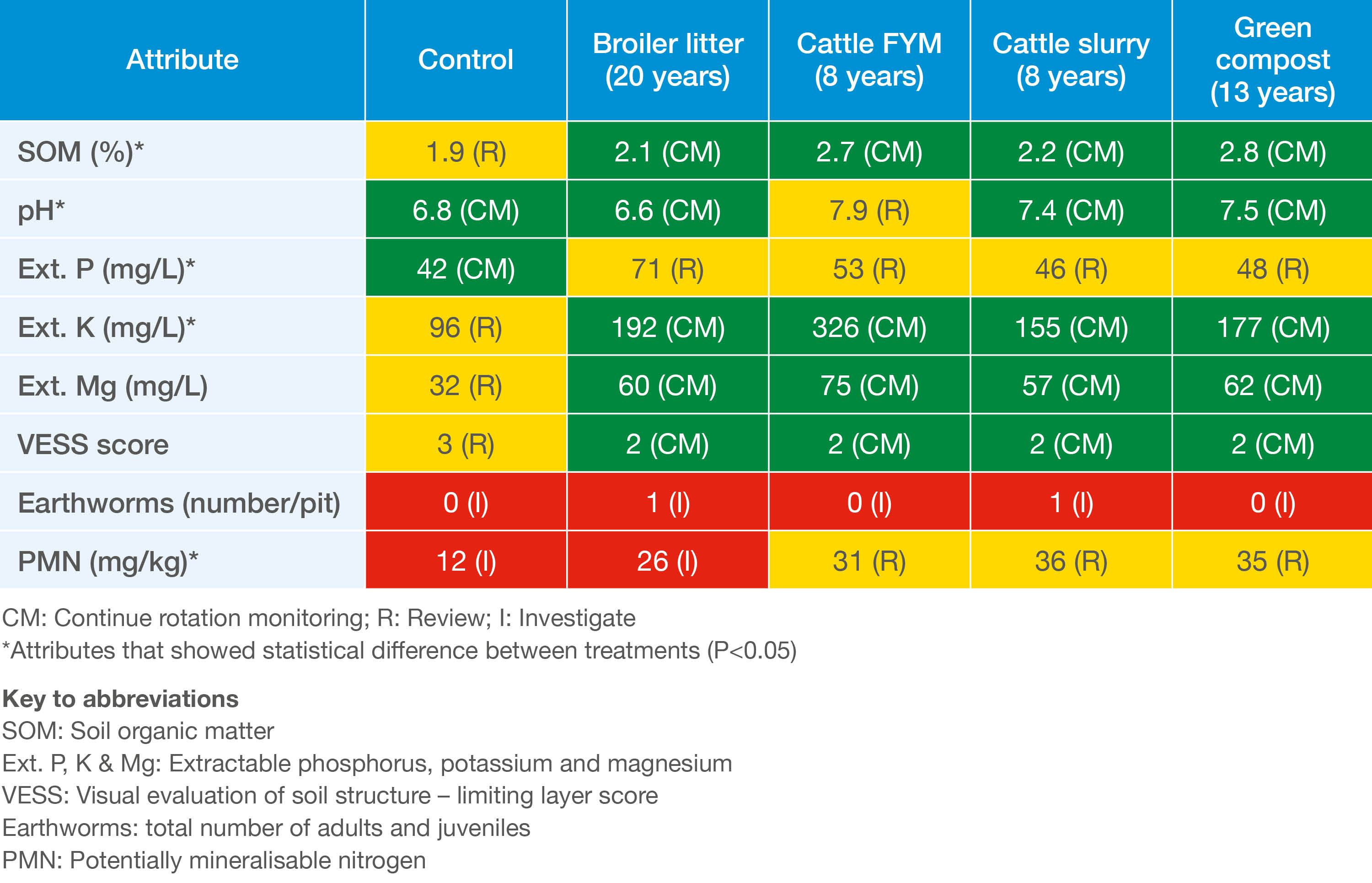- Home
- Knowledge library
- Testing the effect of organic material additions on soil health
Testing the effect of organic material additions on soil health
The soil health scorecard has been tested at a series of long-term experimental sites exploring the key drivers of soil biology. Find out about how organic materials – a food source for soil biology – affect soil health
Assessing soil health using a scorecard approach
Soil health scorecard
The scorecard brings together information about soil chemical (nutrient status, pH), physical (structure) and biological properties. The integrated report uses traffic light coding to identify those properties requiring further investigation to determine the management steps needed to minimise potential risks to crop productivity and the environment.
Long-term experimentation at Harper Adams University
This long-term experiment investigates the impact of repeated organic material additions (at recommended rates) on soil and crop quality in a predominantly arable rotation (cereals and potatoes), previously studied as part of the WRAP DC-Agri experimental programme investigating the use of digestate and compost in agriculture.
Established in 1991 on a sandy loam soil (‘Wick’ Soil Series), treatments include annual applications of cattle farmyard manure (FYM), cattle slurry, green compost, green/food compost and food-based digestate, compared with a control treatment receiving manufactured fertiliser only. Treatments thus provided a variety of nutrient sources for the soil biological community.
Organic material treatments at the long-term Harper Adams University trial, balanced with manufactured fertiliser nitrogen to ensure N supply does not limit crop growth
| Treatment | Applications to autumn 2017 | Organic matter loading (t/ha) |
|---|---|---|
| Control | None | 0 |
| Cattle FYM | 23 years | 129 |
| Cattle slurry | 23 years | 53 |
| Green compost | 7 years | 27 |
| Food-based digestate | 9 years | 7 |
Testing the soil health scorecard at Harper Adams University
Example soil health scorecard from long-term trial at Harper Adams University

Long-term experimentation at ADAS Gleadthorpe
This long-term experiment is investigating the impact of long-term organic material additions (at recommended rates) on soil and crop quality in an arable rotation (cereals and oilseeds), previously studied as part of the Defra Soil-QC experimental programme (SP0530).
Established in 1991 on a loamy sand (Cuckney Soil Series; 6% clay), treatments include annual applications of broiler litter, cattle FYM, cattle slurry, and green compost, compared to a control treatment receiving manufactured fertiliser only. The treatments provide contrasting amounts and types of organic matter which provide a variety of ‘food sources’ for the soil biological community.
Organic material treatments at the long-term Gleadthorpe trial, balanced with manufactured fertiliser nitrogen to ensure N supply does not limit crop growth
| Treatment | Applications to autumn 2019 | Organic matter loading (t/ha) |
|---|---|---|
| Control | None | 0 |
| Broiler litter | 20 years | 85 |
| Cattle FYM | 8 years | 62 |
| Cattle slurry | 8 years | 20 |
| Green compost | 8 years | 47 |
Testing the soil health scorecard at ADAS Gleadthorpe
Example soil health scorecard from long-term trial at ADAS Gleadthorpe

The results show that organic material applications can:
- Significantly increase SOM contents on light textured soils, particularly bulky materials such as FYM and green compost
- Provide valuable nutrients, although repeated annual applications can result in high levels of soil phosphorus (P)
The VESS scores showed some evidence of structural degradation (capping and compaction) where soil organic matter was low on the control treatment.
Earthworm numbers indicated low/depleted levels of biological activity across all treatments. This reflects the low organic matter content of the light soil texture, and plough-based method of crop establishment.
The soil health scorecard here also included recently proposed benchmarks for potentially mineralisable nitrogen (PMN; an indicator of the size of the microbial community involved in the mineralisation of organic nitrogen). There was evidence that PMN was higher on the manure treatments than the fertiliser only control.
Further information
Find out more about the benefits of improving soil organic matter
Read about benchmarking values for potentially mineralisable nitrogen in UK soils
Assessing soil health using a scorecard approach
The above video shows how the soil health scorecard was tested at long-term experimental sites
.jpg)
Topics:
Sectors:
Tags:

